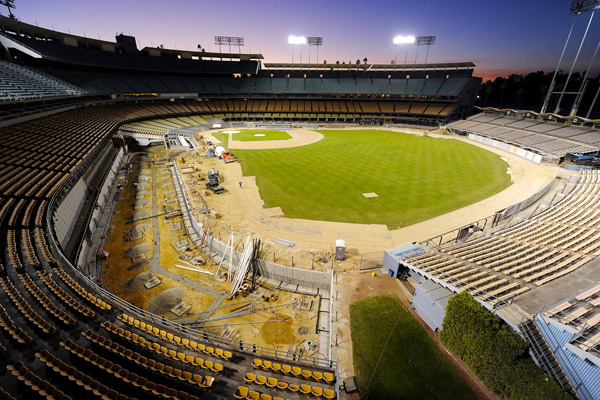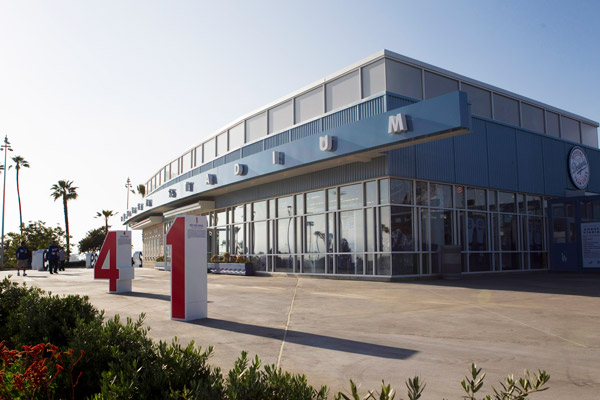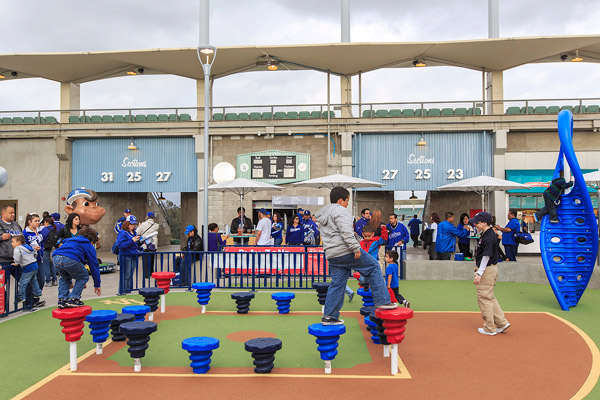If baseball is the great American pastime, what does this make the ballpark?
For Dodger Stadium in Los Angeles, the third-oldest major league diamond, the ballpark is a vast stage—a theater where the narrative of the game and the drama of its grandiose victories and humbling defeats plays out decisively against a backdrop of gently rolling hills and California sunshine. And now, thanks to the iconic stadium’s recent $100 million renovation, it can continue its original and sole role with a newfound level of efficiency, safety, and technological capability.

As a franchise, the Dodgers have a long and storied history, with six World Series titles and 21 National League pennants. Originally established in Brooklyn, New York, in 1883 (and named for Manhattanites’ tongue-in-cheek references to Brooklynites as “trolley dodgers”), the Dodgers moved to LA in 1958—partly because the owners couldn’t get a new stadium built in Brooklyn and partly as a protest of Brooklyn’s resistance to the development of a new stadium.
The team has seen various ownership changes over the years, and in 2012, Guggenheim Baseball Management (comprising Magic Johnson, Stan Kasten, Mark Walter, et al.) purchased the team from Frank McCourt after bankruptcy court proceedings. This led to some changes in the Dodgers’ business roster, including the recruitment of Janet Marie Smith, who had worked on past ballpark development projects, including Oriole Park at Camden Yards in Baltimore, Turner Field in Atlanta, and Fenway Park in Boston. In her new position, one of Smith’s main tasks was to bring her renovation expertise to bear on Dodger Stadium, which was showing signs of age.
“Dodger Stadium is the only surviving stadium from the era it was built in, and its architecture is certainly reflective of that period,” Smith says. “The Dodgers were eager to make certain, as one of the marquee franchises in the United States, that the venue was up to par with the self-image of the team.”

Dodger Stadium also goes by the name “Chavez Ravine,” a metonym that locals affectionately use to pay homage to the ballpark’s colorful past (and, perhaps, as a way of keeping the past alive). This nickname dates back to the 1950s, just a few years before the Dodgers franchise moved. The Federal Housing Act of 1949 freed up funds for the city of Los Angeles, which then used the capital (along with eminent domain) to claim 352 acres of land in the low-income residential area of Chavez Ravine, itself located within LA’s Sulfur Canyon. Ground for the stadium was broken in 1959, with eight million cubic yards of earth moved in, effectively filling the ravine and creating a level field for play.
The ballpark was completed in 1962 at a cost of $23 million (which translates to approximately $177 million today). It was 100 percent privately financed, with precast-concrete units forming a structural framework for 21,000 fans. Captain Emil Praeger (of Praeger-Kavanaugh-Waterbury), the original architect for the stadium, designed the space to be expandable to 85,000, but its present capacity of only 56,000 still makes it the largest ballpark in the world in terms of seating. And, because it’s the oldest ballpark west of the Mississippi, Dodger Stadium is also of an older class of baseball-only stadiums, predating the rise of the multiuse stadium and serving as a steadfast symbol of the national game.
Between the late 1970s and the early 2000s, no major renovations were made on the stadium, but at the close of the Dodgers’ 2005 season, the team began to conduct what would come to be the first of a handful of renovations over the following years. Most of the old bright-yellow, orange, blue, and red stadium seats that had been in use since the 1970s were replaced with seats designed with the stadium’s original yellow, light-orange, turquoise, and sky-blue color palette from 1962. Then, in 2008, the team announced a planned $500 million improvement project for the area surrounding the stadium—an area that would be called Dodgertown, which would include a Dodger museum, shops, restaurants, and park spaces. However, when the then-Frank McCourt-owned club hit financial troubles, Dodgertown was canceled.

After Guggenheim Baseball Management purchased the team, it saw lessons to be learned from the grandiose Dodgertown plans. The new owners announced their own renovation, which looked past the recent playing-field and seating work performed by McCourt for the sake of improving everything else—from the scoreboards to the stadium amenities to the exterior landscaping. “Though there have often been debates swirling around the future of Dodger Stadium, the reality is that we’re playing baseball here, we’re hosting three million fans per year, and it’s unacceptable to not have the basic elements that compare with other parks,” Smith says. “Our assignment was to take the things that touch every fan and get them done—and get them done fast.”
The $100 million renovation was executed in the five-month window between the 2012 and 2013 seasons. The dual, retro 1960s-style video scoreboards in the outfield were upgraded with state-of-the-art display technology, which was then connected to a new and equally technologically advanced in-park sound system. Issues of pedestrian traffic were addressed, both by separating walkways from parking lots and driveways and also by confining level-to-level passage in the ballpark to contained pedestrian spaces. Also, restrooms were upgraded, expanded, and economized (including doubling the number of fixtures and introducing ADA accessibility on all levels) to reduce the historically long bathroom wait times that the park had become notorious for. Finally, new team stores and concession areas were added, and the entry gates were extended to create new exterior plazas and landscaped gathering areas.
“It was a tall order to tackle all of these things in a single off-season,” Smith says. “And, it was made all the more complicated by another major assignment, which was to modernize the clubhouses.” Neither clubhouse had changed much since the stadium’s completion in 1962, but the 2012 renovation gave the visiting team a batting cage and a conditioning room, neither of which it had previously.

Smith has been no stranger to tall orders for ballpark renovations and upgrades. She earned her current position through her previous work with the Atlanta Braves and the Atlanta Hawks, both formerly owned by Stan Kasten, who is now the president of the Dodgers. Additionally, Smith lived in LA in the 1980s, seeing dozens of games at Dodger Stadium at the time, and the opportunity to work there—at one of her favorite ballparks—was a chance she couldn’t pass up. “I know the park as a fan, and I know how different it is from other parks,” she says. “You enter each level at grade; there is no vertical circulation in the building. It’s a very different kind of formula than most ballparks, and it takes getting your head around how unique the building is to understand how to approach it.”
Since making the alterations to its stadium, the Dodgers franchise has already seen big changes taking place. “Fans tend to come earlier, they tend to spend more time on the concourses, there are more things to do,” Smith says. “Some of the security issues we’ve had have completely dissipated by virtue of having positive things for fans to do, [and there are] no more lines for the men’s or ladies’ rooms.”
The overall renovation, a 21st-century upgrade for a 20th-century icon, was completed in March 2013, and it marks the beginning of a new era for the ballpark. With wider thoroughfares, expanded amenities, and the encouragement of increased fan interaction, the stadium, even more than before, reflects the comfort and serenity of the game it plays host to. “I love the sport, partly because of its slow and leisurely pace,” Smith says. “It gives you a lot of time to develop camaraderie with the fans around you, as well as with the place itself.”


